
Features
Products
Biocontrols
What’s next for IPM? New biological solutions and more
As greenhouse production changes, so, too, must IPM programs. Here were the latest innovations spotted at ABIM in Switzerland.
February 18, 2020 By Dr. Michael Brownbridge
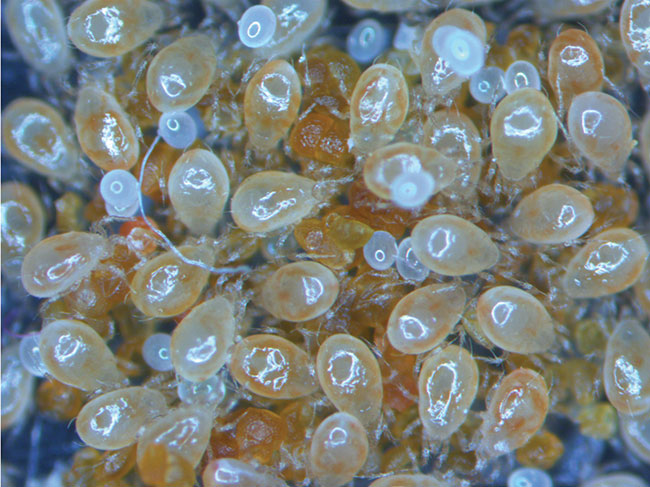 Artemia cysts for predators. credit: Dr. Amir Grossman, Dr Amit Sade, Dr. Shimon Steinberg, Biobee, Israel.
Artemia cysts for predators. credit: Dr. Amir Grossman, Dr Amit Sade, Dr. Shimon Steinberg, Biobee, Israel. IPM programs are never static. They have to continually evolve as production techniques change, new crops are grown and pest dynamics shift. They also change in response to consumer demands and, critically, to our changing climate. IPM systems evolve to accommodate new knowledge and technologies, and every year, advances are made that enhance IPM outcomes and success. Biological inputs are playing a greater role in IPM than ever before, as we seek to improve the economic and environmental sustainability of our production systems. At its core, biocontrol is a preventative strategy and the developments presented here should directly improve the efficacy of bio-centric programs in one way or another, without adversely affecting the biological control agents within them. Collectively, these will allow us to move further along the ‘biologically-based’ IPM track rather than remaining on or reverting to traditional pesticide-based programs.
I was fortunate enough to attend the Annual Biocontrol Industry Meeting (ABIM) in Basel, Switzerland in October (https://www.abim.ch/home.html). This is a meeting focused on the business of biocontrol, bringing together producers and vendors of biological control agents, biopesticides, biostimulants and products that promote and support their activity from around the world. This year, there were 90 exhibitors and 1,227 visitors from over 50 countries and 530 companies. It truly is an amazing event that demonstrates the continued growth, vibrancy and importance of biocontrol to the future of agriculture. Among many other things, the meeting provides a platform for companies to showcase new innovations and services.
Presented in no particular order, here are five technologies that caught my eye and could benefit the Canadian greenhouse industry in one way or another.
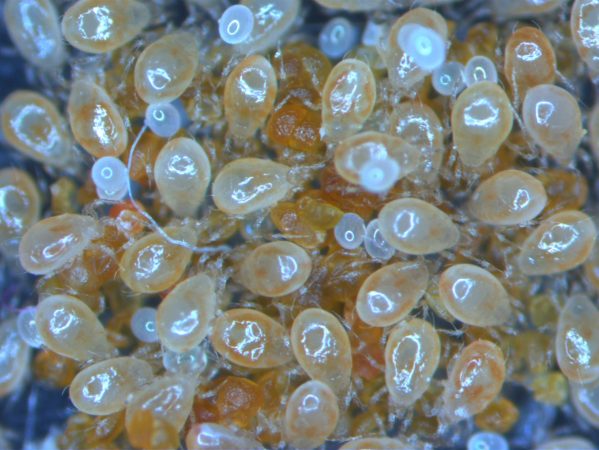
Artemia cysts.
Image courtesy of Dr. Amir Grossman, Dr Amit Sade, Dr. Shimon Steinberg, Biobee, Israel.
1. Supplemental food for predatory species in greenhouse crops: BioArtFeed and BioArtLine
First of all, why consider using supplemental foods in a crop? There are a number of really good reasons behind this. Their use can promote predator establishment in the crop even before pests arrive (the ‘standing army’ approach), and they help prevent populations of generalist predators from collapsing or dying out at times of prey shortage. This means that predators will remain in the crop for an extended period, improving performance and reducing the need to continually replenish them, potentially cutting costs in terms of product and labour. Overall, supplemental foods can improve the outcome and economics of biocontrol programs.
Supplemental foods include Ephestia eggs, prey mites (used in breeder sachets), and pollen (e.g. Nutrimite), but one of the newest and most intriguing supplements are decapsulated Artemia cysts. Several research studies support the potential use of Artemia cysts as a supplement to enhance the establishment and activity of predatory species (insects and mites) in greenhouse crops or as a food source for mass-rearing such species. Biobee has built on these findings to develop commercial products for a range of generalists. Artemia cysts are very nutrient-rich and boost fecundity and longevity. They also have some logistical advantages over the other types of supplemental food in that they can persist in the crop for several weeks, and can be stored in a refrigerator for at least three years. This stability means that their quality is maintained even if there are breaks in the cold chain during distribution and during use.
Artemia cysts enhance the establishment and performance of generalists such as predatory bugs (e.g. Orius), mirids (e.g. Macrolophus) and mites (e.g. swirskii, limonicus). Available in bulk as BioArtFeed, cysts are sprinkled or blown into the crop to feed the predators, which are released before the pests arrive. The goal is to establish the predators in the crop, so that once pests such as thrips or spider mites arrive, there is a ‘standing army’ in place to combat them. The supplement can be re-applied throughout the crop cycle to support predators when pest numbers are low.
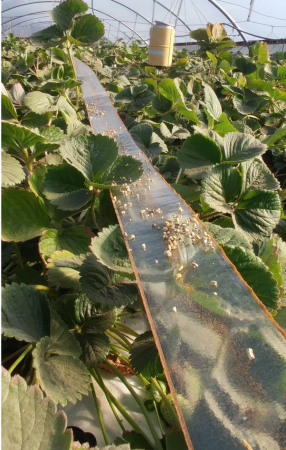
BioArtLine in strawberry. Photo credit: Biobee
For crops where extended feeding is required, or where it is undesirable for there to be any residues on the leaves – ornamentals, strawberries and cannabis, for example – the company has developed the alternative formulation, BioArtLine.1 Two lines of cysts are attached to the edges of plastic tape which is run through the crop. The food is readily accessible to predators, serving as an in-crop source of nutrition over an extended period (up to 10 weeks) without leaving residues on the leaves.
As the list of predators that benefit from this food resource continues to grow, it could also be a game-changer for predators that are more difficult to mass-rear inexpensively, providing a means whereby they could be inoculated in smaller numbers and established in a crop, rather than applying large numbers from the get-go.
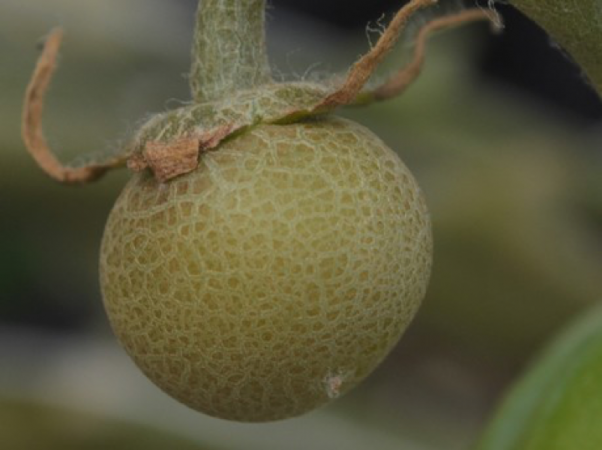
‘Russeting’ caused by TRM. Photo credit: Josh Henry, NC State University.
2. New predators for tomato russet mite: Tydeids
Tomato russet mite (TRM), Aculops lycopersici, is a tiny eriophyid mite, much smaller than the two-spotted spider mite and virtually invisible to the naked eye. It can be a severe pest on other solanaceous crops as well, such as eggplant, pepper and petunia.
Because of their size, these mites are rarely noticed until damage symptoms are observed. Damage by russet mites occurs on stems, leaves and fruits, and is caused as they pierce the cells to feed on the contents. The cells then dry out, leading to symptomatic ‘russeting’ on the affected plant parts. If not controlled, crop losses can be severe. TRM was first reported in Australia in the late 1930s and has subsequently spread around the world.
Finding effective biological controls for this pest has been challenging. Several commercially available predatory mites will feed on this eriophyid, such as cucumeris, californicus, and montdorensis, but control under greenhouse conditions has been poor. The sticky glandular trichomes which cover the leaves and stems of tomato plants impede the movement and activity of many predatory species.
Instead of going big, Biobest decided to go small and discovered two predatory tydeid species, Homeopronematus anconai and Pronematus ubiquitous, which can move easily around the trichomes and will consume all growth stages of TRM. In trials on tomato where Pronematus were introduced in a preventative program, they stopped TRM populations from building. When applied at a high use rate, they virtually eliminated all TRM on the plants. In both cases, plant damage symptoms were significantly reduced. These predatory mites are excellent candidates for use in this manner, and populations can establish and build rapidly in the absence of prey when pollen (Nutrimite) is supplied. Thinking small can pay big dividends, and these diminutive predators may be just the solution for TRM and other eriophyid mite pests in crops such as blackberry, hemp and ornamentals.
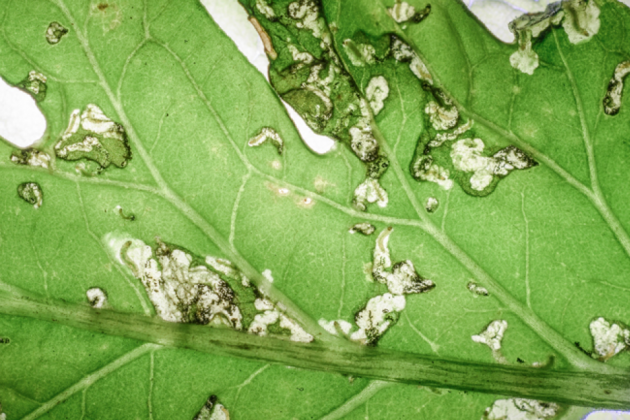
Tuta absoluta larvae and damage on tomato. Tutavir is applied to leaves with the goal of infecting larvae before they start mining the leaves. Larvae infected with the virus will die within the leaves before causing fruit damage. Source: Andermatt Biocontrol
3. A new microbial biocontrol agent for the tomato leafminer: Tutavir
Winner of the International Biocontrol Manufacturers’ Association’s (IBMA) prestigious Bernard Blum Award for novel biocontrol solutions, Andermatt Biocontrol’s Tutavir is the first granulovirus on the market that will selectively control the tomato leafminer, Tuta absoluta.
Although Tuta has not been found in Canadian greenhouses, most greenhouse tomato growers are aware of the threat posed by this pest. Many believe it is more a matter of ‘when’ rather than ‘if’ it will arrive. The moth is native to South America but has spread rapidly around the world and is now prevalent in tomato-growing regions of Europe and North Africa. It has caused major problems in greenhouse tomatoes in the Mediterranean Basin and Northern Europe, where the lack of effective biocontrols has led to the indiscriminate application of broad-spectrum chemicals and multiple negative consequences associated with their use, including the development of resistance, disruption of existing biocontrol programs and environmental degradation.
We can learn a lot from the research and solutions developed in Europe in response to this invasive pest’s arrival. Native (generalist) predators such as mirids (e.g. Macrolophus pygmaeus) and nabids now contribute to control strategies developed for the pest. IPM programs include use of pheromones to monitor and trap adults, biological control and use of selective insecticides. Access to an effective and cost-efficient microbial biopesticide, therefore, is a welcome addition to the Tuta toolbox.
Andermatt has worked to optimize the application strategy for this biopesticide, which relies on weekly sprays at times of highest pest threat. Tutavir is well-suited for use within IPM owing to its high specificity and compatibility with other biocontrol agents. Also, as a virus, it can replicate within the pest population and may provide a source of residual inoculum which can infect healthy Tuta larvae when consumed. Furthermore, because of its unique mode of action (MOA), Tutavir is an important tool for resistance management in conventional and biological production systems.
The product is undergoing registration in Europe, North Africa and South America right now and, owing to the serious threat Tuta poses to greenhouse tomato growers, was granted emergency approval for use in Germany in 2019. Registrations in other jurisdictions will proceed after that. The company has several virus-based products already registered in the US and Canada (available through Andermatt USA and Sylvar Technologies, e.g. Loopex). If Tuta does show up, this would be a logical addition to their portfolio.
4. A totally new type of biological pesticide: Spear-T
Now this is something completely different. Vestaron has invested in the development of a proprietary production platform to generate “peptide-based bioinsecticides which have novel modes of action against major insect and mite pests at scale, and at reasonable cost.” Spear-T is their first product to market and was approved by the U.S. EPA in 2018 for use in greenhouse crops.2 The concentrated liquid formulation can be applied with existing fogging / spraying equipment and has contact activity against aphids, spider mites, thrips and whiteflies. The product has a 4-hour REI, a 0-day PHI and is non-toxic to humans, birds, fish, pollinators and other beneficials.
Through their discovery program, Vestaron identifies naturally-occurring peptides with confirmed insecticidal properties. Peptides are short chains of amino acids; in this case, the peptide in Spear-T is a chain of 40 amino acids and is modeled on spider venom. The genes responsible for production of these peptides are introduced into yeast, and the peptides are produced through fermentation. Spear-T has a novel MOA that is different from any existing class of insecticides. Although it targets sites similar to those affected by neonics and spinosad, insects resistant to these insecticides show no cross resistance. Given its safety profile and activity against tough-to-control greenhouse pests, it has the potential to be an excellent addition to any greenhouse IPM program and will hopefully be available to Canadian growers soon.
5. Enhanced biopesticide formulations
There were several presentations at ABIM on the discovery and development of new products based on bioactive microbes, largely for the control of arthropod pests and diseases. Having a candidate organism is an essential first step, but turning that into something commercially viable is a whole other ball game. It requires appropriate methods of mass production and formulation to obtain a product that is stable, efficacious and cost-effective to use. Although ‘formulations’ are not IPM technologies per se, they are essential to biopesticide performance. It was refreshing to see that several companies recognized the unique challenges created by biopesticides and have engaged in the development of specialised formulations and formulation ingredients. Presentations by two companies in particular stood out: one from UK-based iFormulate (www.iformulate.biz) and the second from German-based specialty chemicals company Evonik Industries (http://www.evonik.com/agriculture).
Efficient mass production and fermentation processes are necessary to produce large quantities of viable and stable microorganisms that retain their insecticidal, antifungal and/or growth stimulating activities, among other properties. Thereafter, formulations are essential to product performance for a number of reasons:
- To stabilize bioprotectants in storage as well as during and after application
- To ensure ease of preparation and application (e.g. for spraying, consider the frustrations caused by poorly formulated products which do not go into suspension and contain particles that clog nozzles!)
- To enhance product performance (e.g. by reducing spray drift, promoting leaf-fastness and persistence after spraying, enhancing foliar penetration, and ensuring efficient delivery of active propagules to the target pest or disease).
Formulations have come a long way, but in the early days of biopesticides, product failure or low field activity could often be attributed to poor stability of the product in storage, too little active material actually reaching the field target and rapid degradation of the active material post-application – all factors that can be improved with better formulations.
iFormulate is actively involved in the development of novel formulations for biopesticides, which promise to bring some highly innovative crop protection products to market in the coming years. Evonik has developed a range of surfactants – super-spreaders, wetting agents, emulsifiers and dispersing agents – for biopesticides which impart significant benefits to a product when applied. These materials physically stabilize solid and liquid formulations and improve dispersion of microorganisms in a spray suspension. Further, these materials have been shown to reduce the number of droplets prone to drift in spray applications, improve adhesion, retention and deposition of spray droplets to leaf surfaces, and enhance homogenous spreading of actives in the soil. The surfactants are highly compatible with a range of microorganisms used in biopesticides and do not interfere with their germination or viability. They have even been shown to improve the efficacy of botanical and microbial pesticides.
Development of new formulation types will create new opportunities and increase the utility of biopesticides across agriculture. They promise to solve problems currently associated with some ‘fragile’ microorganisms, and provide new and more stable products which will allow biopesticides to be effectively used on more crops, both indoor and outdoor, in a more cost-effective manner.
The future– it’s already out there!
Could this be a sneak peek into the near future for Canada’s horticultural sector? There are some exciting developments in the biocontrol and allied worlds just waiting to be tested and registered. While there were many other innovative products presented at ABIM, these examples best represent the different types of biocontrol products currently in development. They show how the field is moving forward and where the biocontrol industry is focusing its efforts to bring not only a greater selection of bioprotection products, but to put more effective options into the hands of growers.
Michael Brownbridge, PhD, is a horticultural research scientist and biological control specialist. He can be reached at michael.brownbridge@gmail.com.
1 BioArtLine is currently available to growers in Canada.
2 Submission of Spear-T registration materials is anticipated for April 2020 in Canada.
Print this page